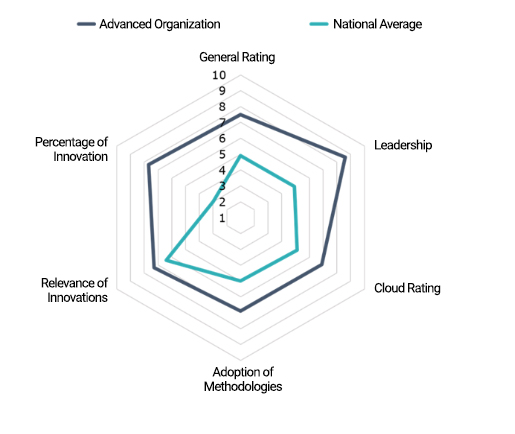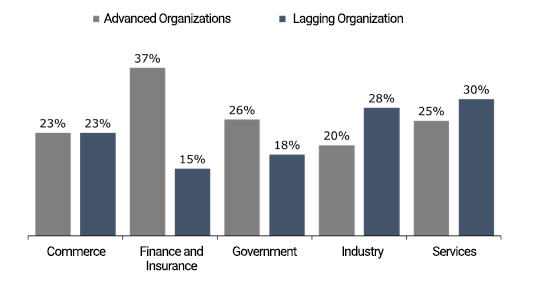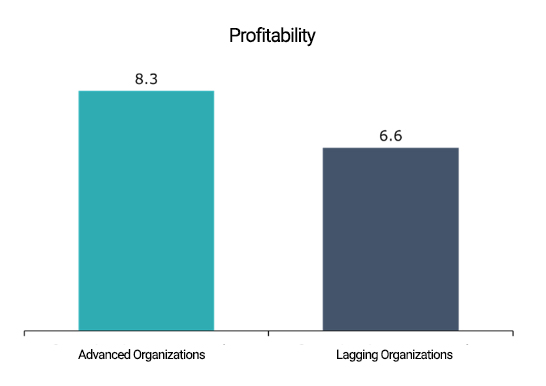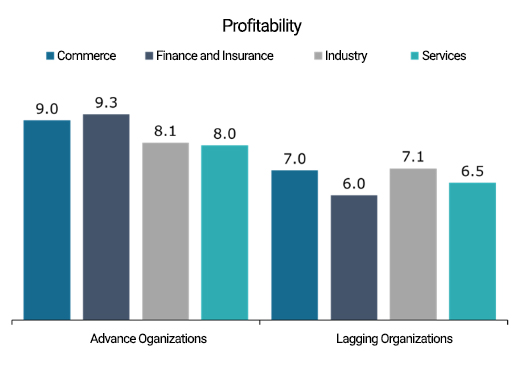By Ricardo Zermeño González
Published on March 7th, 2023
Introduction
The analysis of interviews with CIOs and technology directors of large organizations conducted by Select over the past three years allows us to conclude that organizations that have advanced the most in their digital transformation significantly improve their performance.
It is important to note that if you participated in these studies, you can see your information compared with your sector by accessing the platform. With this benchmarking effort, you will identify your opportunity gaps to continue progressing:
Progress of Digital Transformation
The progress of digital transformation in organizations is evaluated with a general average index composed of five sub-indices, measured on a scale of 1 to 10:
- Leadership: Organizations with a comprehensive transformation plan, a leading official coordinating all efforts, and governance mechanisms.
- Cloud Orientation: Organizations that rely on the operation of public and private clouds, interconnecting and balancing loads between them, i.e., in a hybrid cloud.
- Adoption of Methodologies to Execute Strategies:
- Continuously enrich the customer and employee experience.
- Integrate all customer and partner service channels (omnichannel).
- Design a comprehensive data model and ensure its integrity through data governance mechanisms to generate relevant knowledge for decision-making.
- Develop a microservices architecture of small solution modules integrated by APIs.
- Develop improvements and software in an agile and continuous manner by small workgroups using Agile and DevOps methodologies.
- Delegate decision-making and allow collaborators to innovate and experiment, unleashing a rapid and continuous learning process (open organizations).
- Leveraging the Most Relevant Digital Innovations for Their Transformation Strategy:
- Analytics / Big Data / Data Science
- Internet of Things (IoT)
- Cloud Services
- Mobility (Apps and/or digital services)
- Additive Manufacturing (3D printing)
- Virtual Reality / Augmented Reality
- Artificial Intelligence / Machine Learning
- Cybersecurity
- Blockchain
- Collaboration / Unified Communications
- SDx (software-defined networking and infrastructure orchestration)
- Allocate a High Percentage of Their Total IT Budget to Developing New Things and Innovating.
The more than 300 organizations interviewed are ranked from highest to lowest according to their general average index and are divided into quartiles. In the following radar chart, the profile of the quartile of the most advanced organizations is compared to the national average. While advanced organizations have a general index of 7.5, the national average barely reaches 5. It is clear that advanced organizations have a wide margin for improvement, and the rest are very lagging, especially in their lack of leadership and efforts to innovate.
Profiles of Digital Transformation Progress in Mexico

Digital Transformation of Different Sectors
The sample of organizations was divided by sector, and advanced organizations were identified in each sector. All sectors have advanced organizations. However, the finance and insurance sectors stand out for representing the highest percentage within their sector (37%). This is further evidence that corroborates the digital leadership of these organizations, whose business relies entirely on the management of information or “bits,” according to Negroponte’s taxonomy.
On the other end, the industry and commerce sectors have the lowest percentages of advanced organizations; 20% and 23%, respectively. These sectors include the presence of family-owned, traditional, and smaller-scale organizations that rely on the management of “atoms,” also according to Negroponte’s taxonomy.
Lastly, the government and services sectors have typical percentages of advanced organizations, 26% and 25%, respectively. Among the sample of public organizations, several state governments with a modern vision of digital governance stand out and are worthy of admiration. On the other hand, the services sector is very diverse and composed of companies that cater to consumers and/or businesses, relying to varying degrees on the use of digital innovations (personal services, hotels, hospitals, transportation, logistics, and others).
Sectoral Differences in Digital Transformation in Mexico
(% of advanced and lagging organizations)

Impact of Digital Transformation
At the beginning of the interviews, participants were asked to evaluate the profitability of their businesses over the past three years on a scale of 1 to 10, where 1 is not profitable and 10 is very profitable.
The impact of digital transformation on business profitability is significant; advanced organizations achieve 17% higher profitability than lagging ones. While advanced organizations average 8.3, lagging organizations only achieve 6.6.
Impact of Digital Transformation in Mexico
(business profitability on a scale of 1 to 10, where 1 is low and 10 is high)

Profitability Observed by Sector
Profitability observed by sector shows significant differences, not only due to digital transformation but also to intrinsic characteristics of each sector.
The commerce and finance & insurance sectors exceed 9 in profitability. On the other hand, industry and services achieve around 8.
In lagging organizations, it is noteworthy that finance and insurance show the lowest profitability in the entire sample.
Sectoral Differences in the Impact of Digital Transformation in Mexico
(business profitability on a scale of 1 to 10, where 1 is low and 10 is high)

Conclusions
The progress of digital transformation in organizations is evaluated with a general average index composed of five sub-indices: Leadership, Cloud Orientation, Adoption of Methodologies to Execute Strategies, Leveraging Relevant Digital Innovations, and Resource Allocation for Innovation.
While advanced organizations have a general index of 7.5, the national average barely reaches 5. It is clear that advanced organizations have a wide margin for improvement, and the rest are very lagging, especially in their lack of leadership and efforts to innovate.
There are sectoral differences in the progress and impact of digital transformation. Regardless of their sector, organizations that have advanced the most in their digital transformation significantly improve their performance. Technology is not an end; it is a means to drive business profitability.
[i] Negroponte, N.P., 1995, Being Digital, Vintage Books, A Division of Random House, New York.
[ii] Op cit





